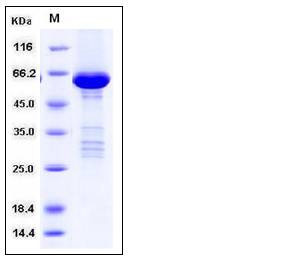Human TRIB2 / TRB2 Protein (His & GST Tag)
C5FW,FLJ57420,GS3955,TRB2,TRIB2
- 100ug (NPP4344) Please inquiry
| Catalog Number | P10725-H19B |
|---|---|
| Organism Species | Human |
| Host | Baculovirus-Insect Cells |
| Synonyms | C5FW,FLJ57420,GS3955,TRB2,TRIB2 |
| Molecular Weight | The recombinant human TRIB2/GST chimera consists of 578 amino acids and predicts a molecular mass of 66 kDa. |
| predicted N | Met |
| SDS-PAGE |  |
| Purity | > 90 % as determined by SDS-PAGE |
| Protein Construction | A DNA sequence encoding the human TRIB2 (NP_067675.1) (Met 1-Asn 343) was fused with the GST tag at the N-terminus and a polyhistidine tag at the C-terminus. |
| Bio-activity | Kinase activity untested |
| Research Area | Cancer |Signal transduction |Protein Kinase |Intracellular Kinase |Tribbles Homolog (TRIB) |
| Formulation | Supplied as sterile 50mM Tris, 100mM NaCl, 1mM GSH, 0.5mM PMSF, pH 8.0 1. Normally 5 % - 8 % trehalose, mannitol and 0.01% Tween80 are added as protectants before lyophilization. Specific concentrations are included in the hardcopy of COA. |
| Background | Tribbles homolog 2, also known as TRB-2, and Trib2, is a member of the protein kinase superfamily and Tribbles subfamily (Trib1, Trib2, Trib3). The identification of tribbles as regulators of signal processing systems and physiological processes, including development, together with their potential involvement in diabetes and cancer, has generated considerable interest in these proteins. Tribbles have been reported to regulate activation of a number of intracellular signalling pathways with roles extending from mitosis and cell activation to apoptosis and modulation of gene expression. Tribbles controls the timing of mitosis in the prospective mesoderm, allowing cell-shape changes to be completed. This mechanism for coordinating cell division and cell-shape changes may have helped Drosophila to evolve its mode of rapid early development. Trib2 was identified as a downregulated transcript in leukemic cells undergoing growth arrest. Trib2-transduced bone marrow cells exhibited a growth advantage and readily established factor-dependent cell lines. Trib2-reconstituted mice uniformly developed fatal transplantable acute myelogenous leukemia (AML). |
| Reference |
